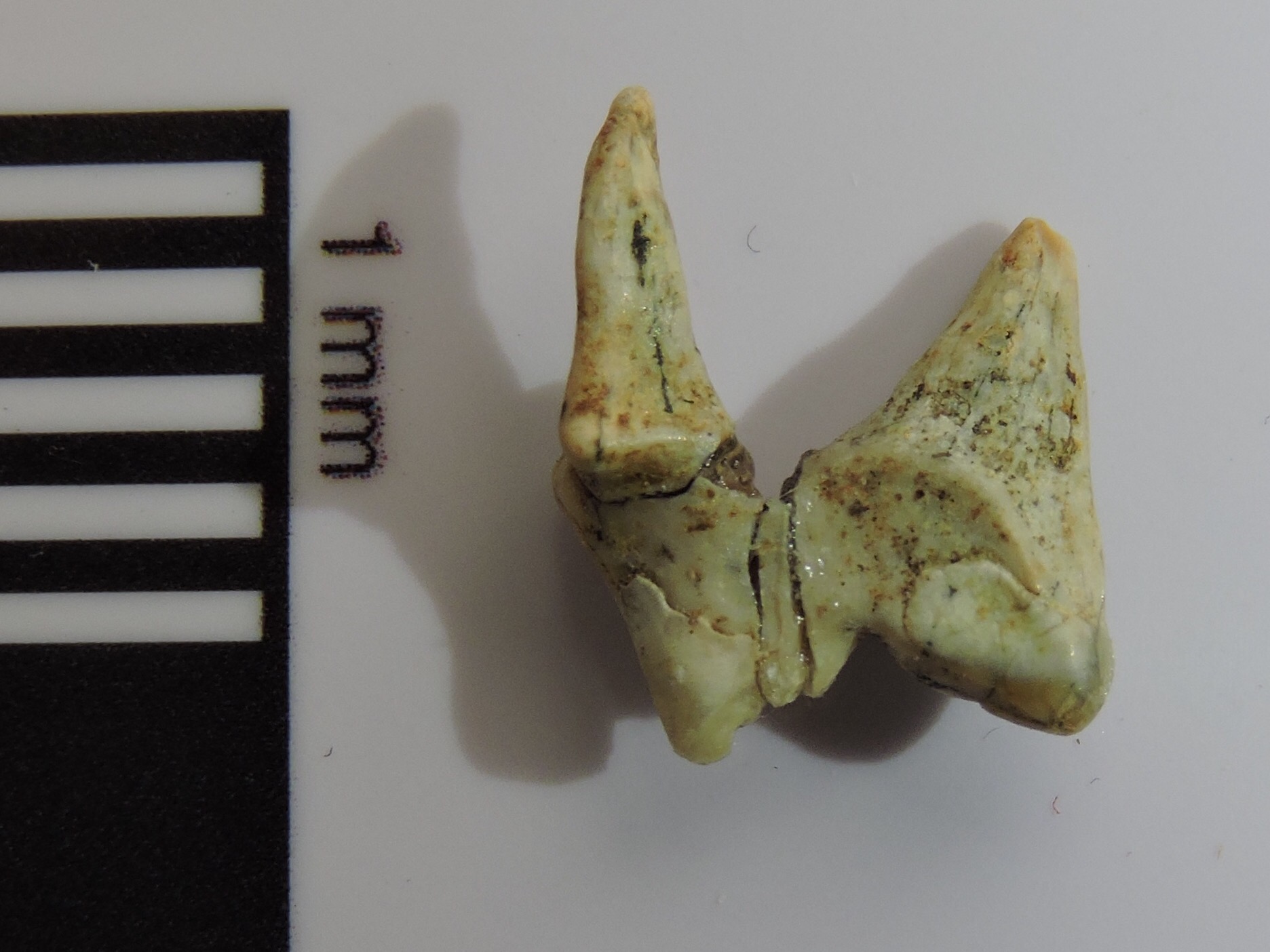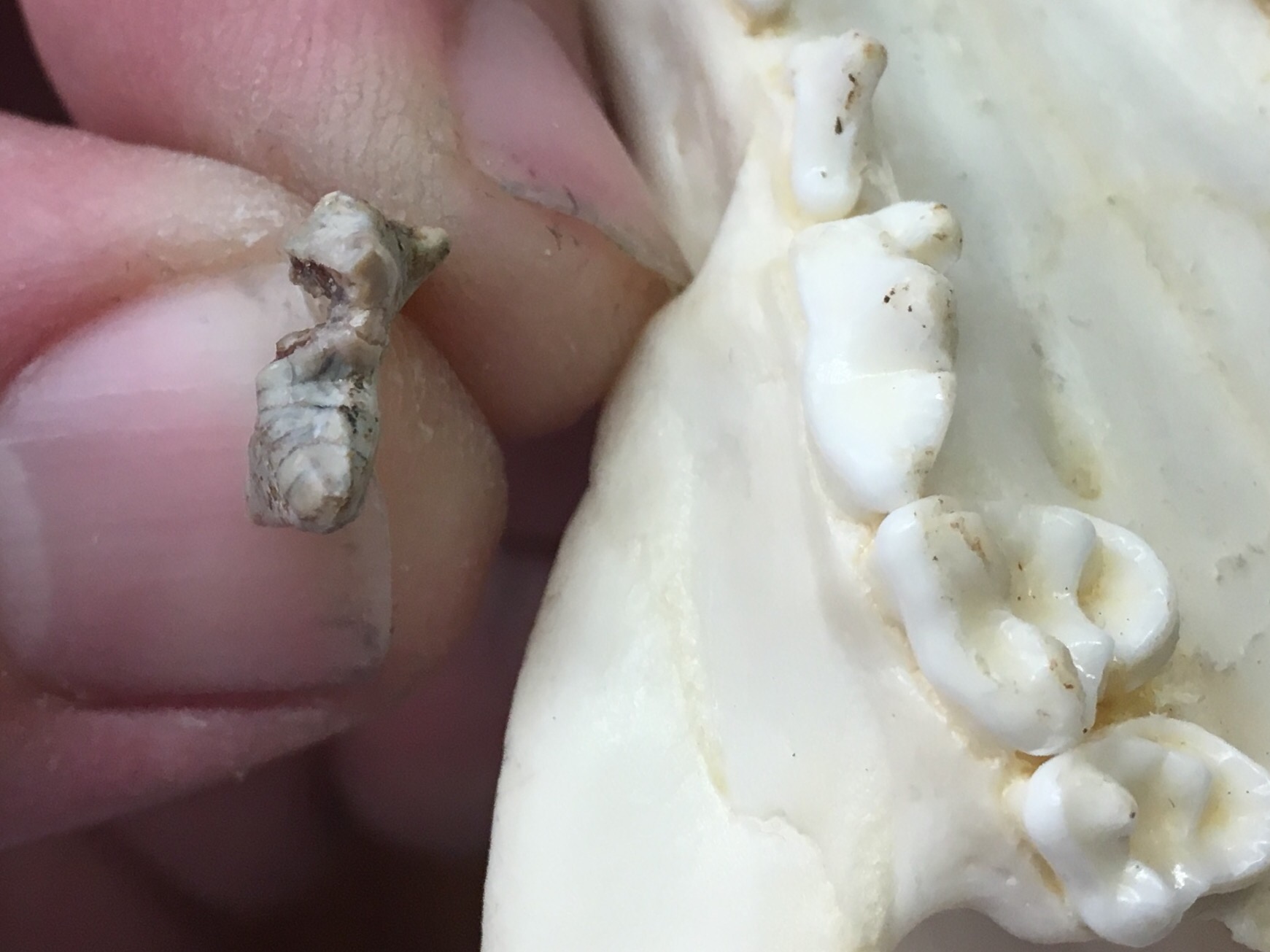 Confession time: I'm not an expert on most of the organisms I feature on Fossil Friday, and it sometimes takes me a fair bit of research to work out what I'm going to say. Because of that, when I'm swamped with other work (like this week), I will usually pick a Fossil Friday specimen that is straightforward so that I can write about it quickly. But sometimes the choice backfires.One of the rarest fossils from Diamond Valley Lake is the bobcat, represented by a single tooth and possibly two other bones. Confirming the identity of a bobcat tooth should be relatively straightforward, especially since we recently acquired a modern bobcat skull for comparison. Our database indicated that the single tooth is a lower first molar, broken into three fragments. In carnivorans such as cats, the lower 1st molar is modified into a large blade-shaped tooth. The upper 4th premolar is modified in a similar way, and these two teeth (called the carnassials) occlude like a pair of scissors, slicing up meat. A quick glance at the three tooth fragments confirmed that the carnassial blade structure was present. As long as I had the tooth out, I decided to glue the fragments back together, with the result shown above in lingual view and below in labial view.
Confession time: I'm not an expert on most of the organisms I feature on Fossil Friday, and it sometimes takes me a fair bit of research to work out what I'm going to say. Because of that, when I'm swamped with other work (like this week), I will usually pick a Fossil Friday specimen that is straightforward so that I can write about it quickly. But sometimes the choice backfires.One of the rarest fossils from Diamond Valley Lake is the bobcat, represented by a single tooth and possibly two other bones. Confirming the identity of a bobcat tooth should be relatively straightforward, especially since we recently acquired a modern bobcat skull for comparison. Our database indicated that the single tooth is a lower first molar, broken into three fragments. In carnivorans such as cats, the lower 1st molar is modified into a large blade-shaped tooth. The upper 4th premolar is modified in a similar way, and these two teeth (called the carnassials) occlude like a pair of scissors, slicing up meat. A quick glance at the three tooth fragments confirmed that the carnassial blade structure was present. As long as I had the tooth out, I decided to glue the fragments back together, with the result shown above in lingual view and below in labial view. The tooth still shows a lot of damage, but one thing that was immediately clear was that the tooth originally had three roots; that meant it was an upper tooth. Instead of a lower left 1st molar, it's actually an upper right 4th premolar. Here's an occlusal view of the tooth:
The tooth still shows a lot of damage, but one thing that was immediately clear was that the tooth originally had three roots; that meant it was an upper tooth. Instead of a lower left 1st molar, it's actually an upper right 4th premolar. Here's an occlusal view of the tooth: The knob projecting to the upper right (toward the front and middling of the skull, or "anterolingually") is called the protocone. A root is located directly under the protocone. The protocone and its associated root were broken off as a separate piece, which I suspect is what caused the misidentification.So, now that the tooth is an upper 4th premolar instead of a lower 1st molar, can we still call it a bobcat? Unfortunately, that's not entirely clear. Below is an occlusal view of a bobcat's upper 4th premolar:
The knob projecting to the upper right (toward the front and middling of the skull, or "anterolingually") is called the protocone. A root is located directly under the protocone. The protocone and its associated root were broken off as a separate piece, which I suspect is what caused the misidentification.So, now that the tooth is an upper 4th premolar instead of a lower 1st molar, can we still call it a bobcat? Unfortunately, that's not entirely clear. Below is an occlusal view of a bobcat's upper 4th premolar: While these teeth are similar in some ways, there are some important differences. For example, the lingual edge of the tooth is slightly convex in the bobcat, but slightly concave in the DVL specimen. The bobcat tooth is also about 10% larger.In terms of size, the DVL tooth is actually closer to a gray fox:
While these teeth are similar in some ways, there are some important differences. For example, the lingual edge of the tooth is slightly convex in the bobcat, but slightly concave in the DVL specimen. The bobcat tooth is also about 10% larger.In terms of size, the DVL tooth is actually closer to a gray fox: While the size is good, the shape of the DVL tooth still differs quite a bit from the gray fox, particularly the shape of the anterior edge. On balance, in spite of the size, I think this tooth is still more similar to a bobcat than anything else I've seen. Until we can study it further, I think we can tentatively call it a bobcat.
While the size is good, the shape of the DVL tooth still differs quite a bit from the gray fox, particularly the shape of the anterior edge. On balance, in spite of the size, I think this tooth is still more similar to a bobcat than anything else I've seen. Until we can study it further, I think we can tentatively call it a bobcat.
